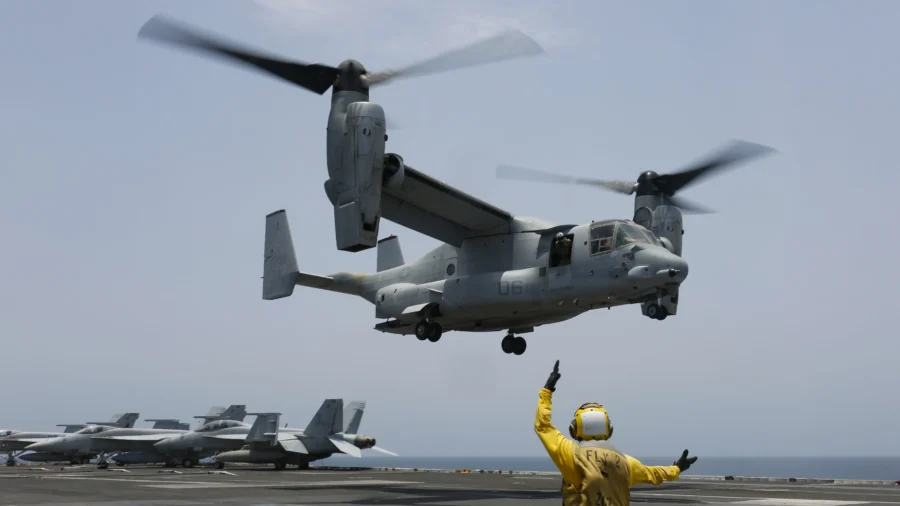House Oversight Committee Chairman James Comer (R-Ky.) is calling on the Pentagon to turn over documentation about the V-22 Osprey program’s safety, after one of the aircraft crashed off the coast of Japan in November, killing eight U.S. Airmen.
“The Committee on Oversight and Accountability is investigating long-term problems regarding the reliability of the V-22 Osprey tiltrotor military aircraft (Osprey). Considering the recent Osprey crash off the shore of Yakushima, Japan, in addition to other crashes during the lifetime of this airframe, the Committee remains concerned about safety and performance issues surrounding the Osprey program,” Mr. Comer wrote in a letter to Secretary of Defense Lloyd Austin on Thursday.
The Osprey is a tiltrotor aircraft with hybrid flight capabilities. The aircraft can tilt its rotors upward for vertical takeoff like a helicopter, and then point the rotors horizontally for forward flight like a typical prop plane. The U.S. Air Force, Navy, and Marine Corps all operate variants of the base V-22 aircraft.
“Since 1992, there have been over a dozen Osprey crashes that have killed over fifty servicemembers,” Mr. Comer’s letter continued.
In August, just months before the Air Force’s CV-22 crash off the coast of Japan, an MV-22B Osprey crashed in Australia, killing three Marines and injuring 20 others on board.
The Marine Corps ordered a safety review after the August crash. The Department of Defense also began coordinating with the various military services on a broader operational stand-down for the Osprey fleet following the most recent crash off the coast of Japan.
In his letter, Mr. Comer noted past inspections of the Osprey fleet had found recurring problems with reduced visibility, engine failure, and faulty gear boxes, as well as a 2019 DOD inspector general report assessing plans to redesign the Osprey may not “correct long-standing problems” with the tiltrotor aircraft.
The Oversight Committee chairman requested several sets of documents, including safety reports, maintenance records, training protocols for flight crews, and DOD plans to upgrade the Osprey or alter its operational use.
House Probe Could Impact the Future of Tiltrotor Aircraft
The House Oversight Committee’s investigation could call into question whether the U.S. military budget should continue to support the Osprey program.
“The American taxpayer has invested heavily in the Osprey program. Each unit cost approximately $120 million to procure, and DoD has purchased over 450 Ospreys, spending billions of dollars in sustainment, operations, and maintenance,” Mr. Comer wrote. “The Committee is keen to understand the rationale behind such a significant expenditure and how DoD balances these costs while ensuring military capabilities and readiness.”
Mr. Comer acknowledged the Osprey doesn’t have the worst safety record in the U.S. military fleet from a statistical standpoint, but said his committee “remains alarmed that most fatalities involving the aircraft have happened during training exercises, not combat operations.”
The Republican lawmaker also acknowledged the tiltrotor concept is not without its advantages, noting the Osprey can carry up to twenty-four combat troops “twice as fast and five times farther than previous helicopters” and that the program supports about 27,000 jobs across 44 states.
“However, if the same tiltrotor technology is planned for use in civilian aircraft or in future military aircraft, additional oversight is needed to ensure public safety,” he continued.
Last year, the U.S. Army awarded a contract for its Future Long Range Assault Aircraft (FLRAA) program to Bell Textron, Incorporated. The Bell team submitted a tiltrotor design they dubbed the V-280 Valor in their bid for the FLRAA contract, which seeks to eventually replace the Army’s UH-60 Black Hawk helicopter fleet.
The aerospace company Leonardo has also made recent advancements on its AW609 tiltrotor aircraft, which it aims to bring to the civilian market. The AW609’s development roots reach back to the 1990s, with links to the Bell XV-15, an experimental tiltrotor aircraft that served as a test bed for the V-22.

